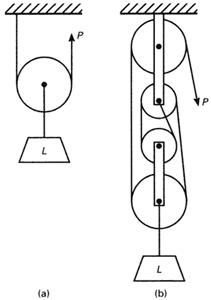A simple machine consisting of a wheel with a flat, crowned, or grooved rim to take a belt, rope, or chain with which a load can be raised. See illustration.
In fig (a), assuming the system is frictionless, the force P in any part of the rope is constant, therefore
2P = L
, where L is the load. In general, nP = L
, where n is the number of supporting ropes. In fig (b), the number of supporting ropes is 4. The mechanical advantage of a pulley system is the ratio of the load, L, to the effort applied to the free end of the rope, P, i.e. mechanical advantage = L/P = L(L/n)-1 = n
. Thus in fig (b) the mechanical advantage is 4. A combination of ropes and pulleys as in fig (b) is called a block and tackle . 
Pulleys
- coordinate
- coordinate geometry
- coordinate system
- coordination number
- Copernican astronomy
- Copernicus, Nicolaus
- core
- Coriolis force
- corona
- corpuscular theory
- corrosion
- cosine rule
- cosmic censorship
- cosmic radiation
- cosmic string
- cosmological constant
- cosmology
- Cottrell precipitator
- coudé system
- coulomb
- Coulomb field
- Coulomb force
- Coulomb's law
- Coulomb, Charles Augustin de
- counter